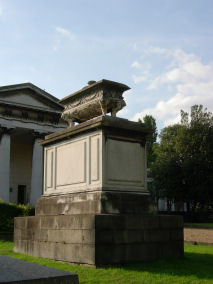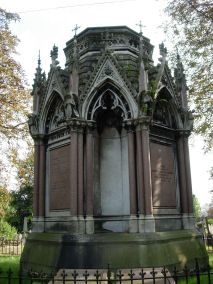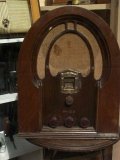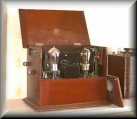SOUND CENTRE - placing of the centre within the sound picture
See also Point of listening = POL
| FIXED SOUND CENTRE - the centre of the sound picture remains fixed in the same place (usual in Standard production) |
| MOVING SOUND CENTRE - 'we go with' - the sound centre moves along with the characters as they talk (going 'up the garden path' so as to speak) |
| This is a crucial rule in radio drama scripting and production. You have to define this in SCRIPTING a scene from the top - FIXED SOUND CENTRE or MOVING SOUND CENTRE. |
| Most radio drama scenes have a FIXED SOUND CENTRE. This organises the sound picture. As listeners, we are placed at the centre of the sound picture. The first character who speaks in the scene is crucial. |
| TO APPLY MOVING SOUND CENTRE - See Level Seven : Script: 'We Go With' |
| Perspective explained by film shot analogy |
| Perspective - construction, width and depth of the sound picture |
| Perceptual filling-in - necessary compensation by the listener for what is blurred or indistinct or omitted |
| Point-of-listening in radio plays - Beck, Alan, 1998, Sound Journal 6. Radio drama's frame & 7. Sound 'in' and 'out' |
| Atmos bed (underneath the scene dialogue) - establishes scene location or scenery |
| 'Mise-en-scène' - representation of the play scene, locations, spaces and perspectives |
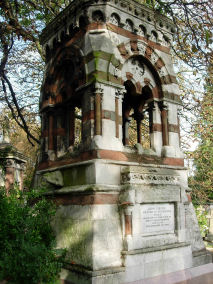
ESTABLISH SCENE AT TOP
| RULE: FOR A CHARACTER SPEAKING AT THE BEGINNING OF A SCENE, WE NEED POSITION THREE (usually) - THE EQUIVALENT OF A FILM MEDIUM SHOT (head to knees). |
| We need to 'see' that character in (film term) MS - In mid-shot, the frame cuts across the subject at the knees. Medium long shot is a tight full-length figure. (MS = medium shot, MLS = medium long shot) |
| It is more difficult for the listeners to hear a new character at the top of the scene, if that person is in position four, further away from the microphone. A word or two shouted is fine. And then an approach to the microphone into position three. |
|
HERE IS AN EXAMPLE FROM A SHORT 5-MINUTE PLAY CALLED 'MEAT IS MURDER'
Situation: autopsy room with doctor (Pierce) working. His assistant Sam is just outside the door.
QUICK FADE UP, MORTUARY EFFECTS. A BED IS PUSHED THROUGH SOME
SWING DOORS INTO A ROOM. 2. SAM (voice off) No worries, need a hand with that one? HERE ARE MY COMMENTS: I recommend a script change at 2, with a bit more script to establish the doctor in a 'mid' shot, to use a film term. Then he can shout off to assistant Sam.
But you cannot begin the scene with that. It just does not work for radio drama. You need to establish his presence first, and that means an inbreath, a little scripted phrase, and then he can call across, with a 'turn'. We then 'see' him in 'mid' shot. Why can the scene not begin with a 'turn' and calling over to Sam, as you have scripted? You are introducing a new character and we have to be 'with' that character for a little or more to establish them. And so we can understand who he is, according to radio drama conventions. In a following scene, because we now know the autopsy room, we will remember the location and Pierce. And you can begin that later scene with a MLS (medium long shot) of the full autopsy room, in effect (position 4 at the microphone). FOR THE FIRST INTRODUCTION OF A NEW CHARACTER, WE NEED THAT POSITION THREE 'SHOT'. Position 4 is too 'fuzzy' without description.
Fixed sound centre standard production realism - eye-level shot - replicates our head level in the Lifeworld - fixed sound centre - paraproxemic Alternatives - by analogy with the film camera angle/level:
Distance and perspective - sound centre and the sound picture:
|
|
|
